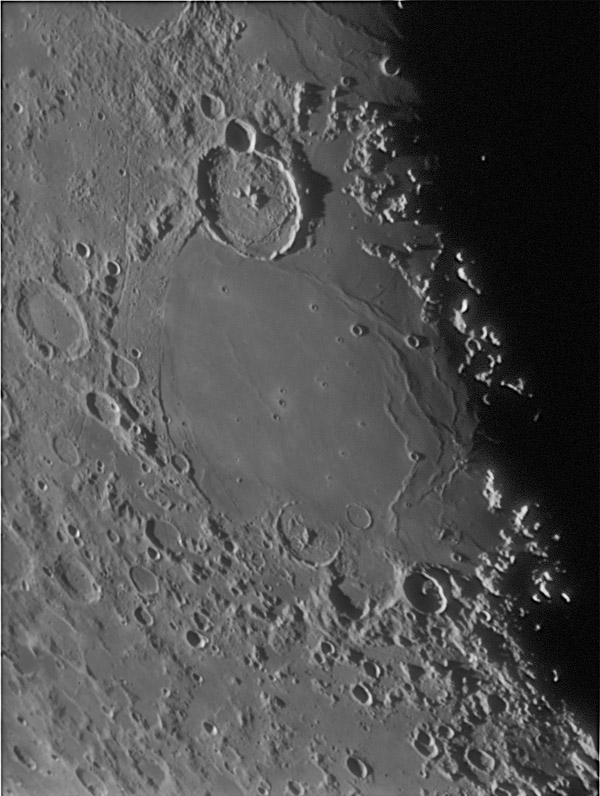Difference between revisions of "November 3, 2010"
| Line 5: | Line 5: | ||
<tr> | <tr> | ||
<td><!-- ws:start:WikiTextLocalImageRule:24:<img src="/file/view/LPOD-Nov3-10.jpg/175905493/LPOD-Nov3-10.jpg" alt="" title="" /> -->[[File:LPOD-Nov3-10.jpg|LPOD-Nov3-10.jpg]]<!-- ws:end:WikiTextLocalImageRule:24 --><br /> | <td><!-- ws:start:WikiTextLocalImageRule:24:<img src="/file/view/LPOD-Nov3-10.jpg/175905493/LPOD-Nov3-10.jpg" alt="" title="" /> -->[[File:LPOD-Nov3-10.jpg|LPOD-Nov3-10.jpg]]<!-- ws:end:WikiTextLocalImageRule:24 --><br /> | ||
| − | <em>image by [mailto:howardeskildsen@msn.com | + | <em>image by [mailto:howardeskildsen@msn.com Howard Eskildsen], Florida</em><br /> |
</td> | </td> | ||
<td>With lunar orbiting satellites and many telescopic images, high resolution provides extreme closeups of individual landforms. But at the eyepiece, I almost always use a moderate magnification to take in an entire region. Howard's view of Humorum illustrates this philosophy by encompassing most of the structural basin including the main rim and mare ridges that define inner rings. Sitting on the edges of the mare are large craters that were tilted downward as the weight of the mare caused the basin floor to subside. On the southern edge, mare lavas poured over crater rims, flooding the crater floors. On the north, the rim of the large crater Gassendi was not surmounted by lavas, but they rose up fractures and colonized the low, southern part of the floor. There are also differences between the eastern and western part of the mare and the basin rims. The western wall is mountainous and continuous except where smashed by craters, whereas the eastern wall is much more fragmented and broken up. <br /> | <td>With lunar orbiting satellites and many telescopic images, high resolution provides extreme closeups of individual landforms. But at the eyepiece, I almost always use a moderate magnification to take in an entire region. Howard's view of Humorum illustrates this philosophy by encompassing most of the structural basin including the main rim and mare ridges that define inner rings. Sitting on the edges of the mare are large craters that were tilted downward as the weight of the mare caused the basin floor to subside. On the southern edge, mare lavas poured over crater rims, flooding the crater floors. On the north, the rim of the large crater Gassendi was not surmounted by lavas, but they rose up fractures and colonized the low, southern part of the floor. There are also differences between the eastern and western part of the mare and the basin rims. The western wall is mountainous and continuous except where smashed by craters, whereas the eastern wall is much more fragmented and broken up. <br /> | ||
<br /> | <br /> | ||
| − | <em>[mailto:tychocrater@yahoo.com | + | <em>[mailto:tychocrater@yahoo.com Chuck Wood]</em><br /> |
<br /> | <br /> | ||
<strong>Technical Details</strong><br /> | <strong>Technical Details</strong><br /> | ||
| Line 21: | Line 21: | ||
<br /> | <br /> | ||
<hr /> | <hr /> | ||
| − | <div>You can support LPOD when you buy any book from Amazon thru [http://www.lpod.org/?page_id=591 | + | <div>You can support LPOD when you buy any book from Amazon thru [http://www.lpod.org/?page_id=591 LPOD!]<br /> |
</div> | </div> | ||
---- | ---- | ||
===COMMENTS?=== | ===COMMENTS?=== | ||
| − | + | Register, and click on the <b>Discussion</b> tab at the top of the page. | |
Revision as of 17:26, 11 January 2015
A Basinful of Features
 image by Howard Eskildsen, Florida |
With lunar orbiting satellites and many telescopic images, high resolution provides extreme closeups of individual landforms. But at the eyepiece, I almost always use a moderate magnification to take in an entire region. Howard's view of Humorum illustrates this philosophy by encompassing most of the structural basin including the main rim and mare ridges that define inner rings. Sitting on the edges of the mare are large craters that were tilted downward as the weight of the mare caused the basin floor to subside. On the southern edge, mare lavas poured over crater rims, flooding the crater floors. On the north, the rim of the large crater Gassendi was not surmounted by lavas, but they rose up fractures and colonized the low, southern part of the floor. There are also differences between the eastern and western part of the mare and the basin rims. The western wall is mountainous and continuous except where smashed by craters, whereas the eastern wall is much more fragmented and broken up.
|
You can support LPOD when you buy any book from Amazon thru LPOD!
COMMENTS?
Register, and click on the Discussion tab at the top of the page.



